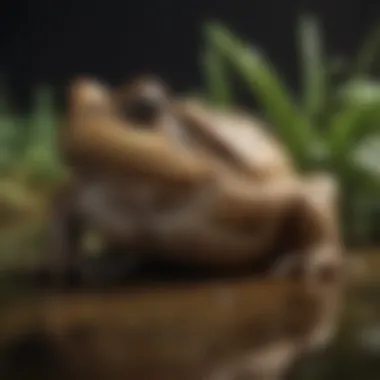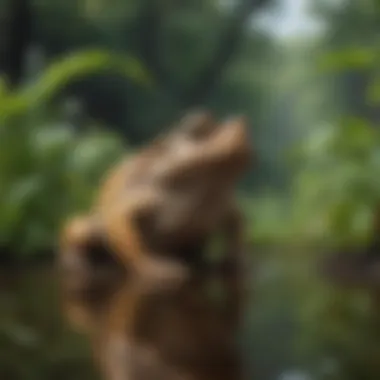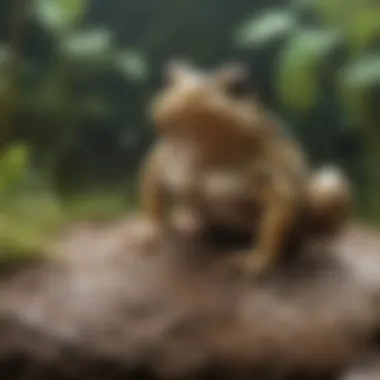Unveiling the Intriguing Ecology of King Toads


Intro
King toads, also known as Rhinella marina, have captivated the attention of herpetologists and nature enthusiasts alike. These amphibians occupy a unique ecological niche and possess remarkable traits that set them apart from other species. In this article, we will explore various aspects of king toads, from their biological characteristics and behavior to their environmental effects and conservation challenges. By examining these factors, we aim to foster a deeper understanding of king toads and their significance in ecosystems worldwide.
Fascinating Facts About the Animal
Unique Characteristics
King toads are renowned for their impressive size, with some individuals reaching lengths upwards of 25 centimeters. Their skin is often rough and warty, providing ideal camouflage among various natural environments. The coloration ranges from muted browns and greens to vibrant yellows, enhancing their ability to blend seamlessly into their surroundings. This adaptability allows them to thrive in diverse habitats, including rainforests, grasslands, and even urban areas.
Another notable feature of king toads is their parotoid glands, which secrete toxic substances as a defense mechanism against predators. These toxins can cause serious harm to animals attempting to consume them, allowing king toads to avoid predation effectively.
Extraordinary Abilities
Beyond their physical attributes, king toads exhibit fascinating behaviors. One significant aspect of their biology is their vocalization. During mating season, males produce deep, resonant calls that can travel long distances. This serenade not only attracts females but also serves as a territorial signal to other males.
Moreover, king toads are excellent at migrating. They journey considerable distances to find suitable breeding sites and food sources. This ability to adapt is crucial for their survival, particularly in environments that undergo seasonal changes.
Behavior and Habitat
Natural Habitats
King toads thrive in various habitats, ranging from tropical rainforests to arid regions. Their resilience to different climates is a vital adaptation. They are primarily nocturnal, foraging for insects and other small prey during the cover of night. This eating behavior enables them to maintain a balanced ecosystem by controlling insect populations.
Social Structures
King toads exhibit intriguing social behavior, particularly during breeding seasons. They often gather in large groups, creating a chorus of croaks and calls. These gatherings can lead to fierce competition among males as they strive to secure mates. Despite this competitiveness, king toads do not display lifelong pair bonds; instead, their interactions are predominantly seasonal.
Recent Scientific Discoveries
Latest Research Findings
Recent studies have focused on the ecological impact of king toads in non-native environments. Their introduction into places such as Australia has led to significant ecological shifts. Researchers are particularly concerned about the decline of native species that fall victim to the king toad's predatory behaviors or succumb to its toxins.
Breakthroughs in Animal Biology
Additionally, advancements in genetic research have provided insight into the evolutionary adaptations of king toads. Studies suggest that their ability to thrive in diverse habitats is linked to specific genetic traits that confer resilience against environmental stressors. This ongoing research underscores the importance of studying these amphibians, aiming to understand their role in ecosystems and inform conservation efforts.
Cultural Significance
Animals in Folklore
King toads hold a prominent place in various cultures around the world. In some regions, they are regarded as symbols of good fortune, while in others, their toxic nature has led to myths and superstitions. Understanding these cultural perspectives can provide a broader context for the relationship between humans and wildlife.
Influence on Art and Literature
Their unique appearance and behaviors have inspired numerous artists and writers throughout history. From paintings to literature, king toads often appear as symbols of transformation and resilience.
This cultural significance further highlights the need for conservation, emphasizing that protecting king toads means preserving not just a species but also a rich cultural heritage.
Intro to King Toads
King toads, known scientifically as Rhinella marina, represent an important amphibian species. This section provides a fundamental understanding of these creatures, emphasizing their significance in various ecosystems. By exploring their biology, behavior, and conservation status, one can appreciate their role in maintaining ecological balance. This is not merely an academic inquiry. Understanding king toads is crucial for promoting biodiversity and assessing environmental health.
Defining King Toads
Defining king toads involves recognizing their unique biological and ecological attributes. King toads are large, robust amphibians that can weigh over a kilogram. Their skin is often rough and warty, providing both protection and camouflage in their natural habitat. The coloration of their skin can range from gray to brown, effectively blending them into their surroundings.


King toads are known for their distinctive parotoid glands, which secrete a potent toxin when the animal feels threatened. This adaptation serves as a defense mechanism against potential predators. Their vocalizations are another defining characteristic, especially during the mating season, when males emit loud calls to attract females. Overall, these traits contribute to their survival and reproductive success in the wild.
Historical Context
The historical context of king toads reveals much about their interactions with humans and their native habitats. Originally from Central and South America, king toads have a complex timeline of introduction to other areas. In the 1930s, they were introduced to various regions, including Australia, in an attempt to control agricultural pests. However, the results were catastrophic, leading to ecological imbalances.
These toads quickly adapted to their new environments, often resulting in the decline of native species. The unintended consequences of their introduction reflect ongoing challenges in wildlife management and species conservation. The history of king toads thus serves as a cautionary tale in ecological intervention and highlights the need for informed conservation efforts.
Physical Characteristics
Understanding the physical characteristics of king toads is crucial in appreciating their biology and role in the ecosystem. These traits not only help in the identification of the species but also reflect their adaptations to the environment. King toads exhibit certain features that directly influence their behavior, survival strategies, and interactions with other species. Knowing these characteristics enables veterinarians and wildlife biologists to monitor their populations and health effectively.
Size and Coloration
King toads are notable for their large size and distinctive coloration. An adult king toad can grow up to 25 centimeters in length, making it one of the largest toad species. Their skin varies in color, typically featuring shades of brown, green, or gray, often with darker mottling. This variation provides them with a level of camouflage against predators, enhancing their chances of survival.
The size and coloration are not merely superficial attributes. The skin of king toads contains glands that produce toxins, which can deter potential threats. The variation of coloring among individuals can also indicate their environmental adaptations. For instance, those in drier environments may exhibit lighter colors, optimizing thermoregulation.
Unique Features
In addition to size and coloration, king toads possess several unique anatomical features. One prominent aspect is their parotoid glands, which are located behind their eyes. These glands secrete bufotenin and other toxic compounds, playing a vital role in their defense mechanism. This secretion can be harmful or even fatal to predators, making king toads less appealing as prey.
Their limbs are also proportionately longer than those of many other toad species, allowing for better mobility. King toads have strong hind legs that enable them to leap considerable distances. This ability is essential for escaping threats and moving between habitats in search of food.
Overall, these physical characteristics underscore not only the king toad’s evolutionary adaptations but also their importance in the ecological landscape.
Habitat and Distribution
Understanding the habitat and distribution of king toads is crucial for their conservation and management. These toads not only reflect environmental conditions, but they also reveal the biodiversity of their ecosystems. King toads thrive in specific environments that provide the necessary conditions for their survival. Their habitat impacts their growth, breeding, and general behavior. Moreover, local environmental changes can significantly affect their populations.
Natural Habitat
King toads typically inhabit tropical and subtropical regions, favoring areas with ample moisture. They can often be found near rivers, lakes, and wetlands. These habitats are rich in the food sources they require, such as insects and other invertebrates. Forested areas provide both shelter and breeding grounds for king toads. During the rainy seasons, they are more active as water bodies expand, allowing for increased food availability and mating opportunities.
The composition of the habitat can greatly affect the toads' health. Areas with stagnant water may lead to higher risks of disease and stagnation of food sources. Conversely, flowing waters can foster a more diverse food web, benefiting king toads greatly. Their presence in these habitats indicates stable ecosystems. Protecting and monitoring these areas is essential for maintaining king toad populations and preserving the intricate balance of their environments.
Geographical Range
The geographical range of king toads varies significantly based on climate and human activity. They have established populations across various countries in Central and South America, but their range has shifted due to habitat destruction and introduction to non-native areas. In Australia, for instance, the release of cane toads has created considerable ecological impacts, leading to concerns about biodiversity and ecosystem health.
Factors that influence their range include climate change, urbanization, and agricultural development. As temperatures rise and some habitats degrade, king toads may migrate in search of better conditions. This movement must be monitored, as invasive populations can disrupt local ecosystems.
Conserving habitats and understanding the current geographical distribution of king toads will help prevent further decline in their populations and mitigate human impacts on their lifecycle.
Maintaining accurate records of where these toads are found is vital for conservation efforts. The collaboration of wildlife biologists and local communities can aid in collecting data to track these amphibians, ensuring effective protection strategies are implemented.
Behavioral Traits
The behavioral traits of king toads are crucial in understanding their ecological roles and interactions within their environment. By examining their feeding and reproductive behaviors, we can gain insights into the adaptability and survival strategies of this unique amphibian. Moreover, understanding these traits helps in the conservation efforts aimed at protecting king toads and their habitats.
Feeding Habits
King toads are opportunistic feeders, consuming a variety of prey. They primarily eat insects, although larger individuals may prey on small mammals, amphibians, or even birds. This diverse diet allows them to thrive in different environments, adapting to the available food sources. Feeding typically occurs at night, a behavior that reduces competition with other predators. The toads often rely on their keen sense of sight and a well-developed tongue to capture prey efficiently.
"King toads exhibit remarkable adaptability in their feeding strategies, which is essential for their survival in changing environments."
The consumption of varied prey not only contributes to the individual toad's health but also plays a role in controlling insect populations in their ecosystem. This balance makes king toads significant contributors to the ecological dynamics of their habitats. However, when food sources dwindle due to habitat loss or environmental changes, their ability to sustain themselves can be jeopardized.


Reproductive Behavior
The reproductive behavior of king toads is equally fascinating. Mating typically occurs during the rainy season, when conditions are optimal for breeding. Males attract females by croaking loudly, often engaging in a chorus to increase their chances of being heard. The mating process is marked by amplexus, where the male grasps the female from behind, aiding in fertilization as she lays her eggs.
King toads can produce a significant number of eggs, sometimes thousands at a time. This high fecundity is a survival strategy, ensuring that at least some offspring reach maturity despite high predation rates on eggs and tadpoles. After a few days, the eggs hatch into tadpoles, which continue to grow and develop in aquatic environments before transforming into adult toads.
The behavioral traits associated with their reproduction not only highlight the adaptability of king toads but also underline the challenges they face. Environmental changes, such as alterations in precipitation patterns or habitat destruction, can disrupt their breeding cycles. Understanding these patterns is vital for effective conservation strategies.
Ecological Role
King toads serve a significant ecological role within their habitats. Understanding this role helps illuminate their contributions and the subsequent necessity for conservation. Their presence influences various ecological aspects, from prey-predator dynamics to the overall health of ecosystems.
Impact on Other Species
King toads primarily impact their immediate ecosystem by acting as both predator and prey. They consume a wide variety of invertebrates, which helps regulate those populations. This includes insects, snails, and worms. By keeping these species in check, king toads maintain a balance that promotes plant growth and biodiversity.
Moreover, they serve as prey for larger animals such as birds, snakes, and some mammals. This predator-prey relationship is essential for the food web. Given this dynamic, a decrease in king toad populations can create an overflow of their prey species, which may then lead to imbalances within the ecosystem.
"King toads play a pivotal role in maintaining the delicate balance of their habitats, serving both as predators and prey."
Furthermore, their presence can affect species distribution. For example, in areas where king toads are prevalent, smaller amphibian populations might decline. This dynamic creates competitive pressure on native species, potentially leading to endangerment. Protecting king toads is thus a matter of preserving intricate ecological webs.
In summary, the impact of king toads on other species is multifaceted. They help control prey populations, support biodiversity, and maintain ecological balance. This makes their conservation a crucial aspect of ecosystem health.
Role in Ecosystem Functioning
The role of king toads in ecosystem functioning cannot be overstated. They contribute to nutrient cycling and energy flow within their environments. Through their feeding habits, they facilitate the transfer of energy from lower to higher trophic levels.
King toads are often found in diverse habitats ranging from tropical forests to suburban areas. Their adaptability allows them to thrive in various ecosystems, which further extends their ecological influence. They help in the turnover of organic material, breaking down matter and releasing nutrients back into the soil.
Additionally, king toads influence the behavior and populations of other species. Their breeding activities, for instance, produce immense amounts of offspring. These tadpoles contribute to the aquatic food chain, providing a food source for fish and other aquatic creatures.
Their calling sounds during mating seasons also impact local wildlife. These sounds can attract various species, indicating the presence of resources such as water and shelter.
King toads are key players in nutrient cycling, species interactions, and energy dynamics. Their decline could adversely impact the reliability of resources and stability of ecosystems.
Conservation Status
Conservation status is a critical aspect to consider when discussing king toads. Examining their threats and conservation efforts provides insights into their current situation and what can be done to ensure their survival. King toads face various challenges that threaten their populations and ecological balance. Understanding the dynamics of these threats and the response of conservation initiatives is essential for maintaining their habitats and ecosystems.
Threats to Survival
King toads encounter numerous threats in the wild. These challenges can stem from both natural occurrences and human activities. The following are some significant threats:
- Habitat Loss: One of the primary issues facing king toads is habitat destruction. Urban expansion, agriculture, and deforestation lead to the loss of breeding and feeding grounds. The encroachment of human settlements disrupts their ecological niches.
- Pollution: Water pollution from industrial runoff, pesticides, and fertilizers poses significant risks to king toads. Contaminated water sources can affect their health and reproductive success.
- Climate Change: Shifts in climate patterns influence the habitats where king toads thrive. Increased temperatures and altered rainfall patterns affect their life cycles and food availability.
- Invasive Species: The introduction of non-native species can disrupt local ecosystems. These species often compete for resources, leading to declines in native amphibian populations like king toads.
“Understanding and mitigating these threats is essential for the conservation of king toads and their ecosystems.”
Addressing these threats is crucial for sustaining this unique amphibian and the wider environment in which they inhabit.
Conservation Efforts
Various conservation efforts have been implemented to protect king toads and their habitats. Recognizing their ecological importance has led to initiatives aimed at reducing threats and promoting sustainable populations. Key conservation strategies include:
- Protected Areas: Establishing reserves and protected zones helps secure vital habitats for king toads. These areas create safe spaces for breeding and foraging, free from human interference.
- Restoration Projects: Restoration of degraded habitats can enhance the living conditions for king toads. These projects often involve replanting native vegetation, removing pollutants, and creating suitable aquatic environments.
- Education and Awareness: Informing the public about the ecological role of king toads is essential. Educational programs can foster community involvement in conservation efforts and promote better environmental practices.
- Research and Monitoring: Continued scientific research allows for a better understanding of king toads’ biological needs and threat dynamics. Monitoring populations and habitats can inform targeted conservation measures.
In summary, the conservation status of king toads underscores the importance of proactive measures to mitigate threats and foster their survival in the wild.


King Toads and Human Interaction
Understanding the interaction of king toads with humans is essential for various reasons. As king toads adapt to environments influenced by human activities, these interactions have significant implications for the ecology and the conservation of the species. By exploring cultural significance and the challenges of cohabitation, we can better appreciate the complexities of these relationships.
Cultural Significance
King toads hold a prominent place in various cultures. They often symbolize resilience and adaptability due to their robust nature. In some regions, they are considered spiritual creatures, embodying notions of transformation and rebirth. Their appearance in folklore and art reflects deeper connections between humans and the natural world. This cultural tie prompts people to take a greater interest in their conservation. Furthermore, understanding the myths and stories surrounding king toads can help foster respect and stewardship for these amphibians.
- In several indigenous cultures, they are seen as totems of prosperity and health.
- In literature, their image often represents wisdom and secrecy.
- Their presence in traditional medicine is noted in certain cultures, although this can lead to misconceptions and misuse.
By examining these aspects, we can realize the potential of king toads to evoke a sense of responsibility for environmental protection. People who feel connected to an animal are generally more inclined to support conservation measures.
Challenges in Coexistence
Despite the cultural reverence for king toads, challenges arise in their coexistence with humans. Urban expansion and agriculture often encroach on their natural habitats. As humans modify landscapes, king toads face increased predation, competition for resources, and habitat disruption.
Key challenges include:
- Habitat Loss: Wetlands and forests are often drained or cleared for development, impacting the breeding grounds of king toads.
- Pollution: Agricultural runoff and chemicals can contaminate water supplies, harming not just king toads but the ecosystems they inhabit.
- Human Encroachment: Roads and urban areas can fragment their habitat, making it difficult for them to migrate and find mates.
Conservationists emphasize the need for sustainable practices that both support human needs and protect king toads.
Efforts to minimize these challenges include the establishment of protected areas, community awareness programs about the ecological value of king toads, and creating corridors that allow safe movement across landscapes. By addressing the challenges of coexistence, we can work towards a balance where both king toads and humans thrive in harmony.
Scientific Research
Scientific research on king toads is crucial for understanding their biology, behavior, and ecological significance. Such studies provide insights into the complex interactions between king toads and their habitats. These insights inform conservation strategies, promoting better coexistence with human populations. Moreover, research highlights how the decline of king toad populations can disrupt local ecosystems, emphasizing the need for targeted conservation efforts.
Current Studies
Current studies focus on various aspects of king toad biology. Researchers analyze their reproductive behaviors, which include the timing and environmental factors affecting mating. For instance, studies indicate that temperature and rainfall patterns significantly influence breeding cycles.
Furthermore, investigations are also being conducted on population genetics. These studies seek to understand genetic diversity among king toad populations across geographical locations. Such knowledge can help assess the impact of habitat fragmentation.
Key Research Areas Include:
- Behavioral Ecology: Understanding feeding and mating habits.
- Toxicology: Examining the effects of toxins on predators and their implications.
- Ecosystem Impact: Analyzing the role of king toads in pest control and their influence on biodiversity.
Future Directions
Future directions in king toad research must address several critical gaps. One promising area is the study of how climate change affects king toad habitats and survival. Increased temperatures and altered precipitation patterns could have severe consequences for their reproductive success.
Additionally, there is a need for more comprehensive studies on their interactions with non-native species. Understanding how these interactions impact both king toads and local ecosystems is vital for developing effective management strategies.
Future research should also prioritize collaborations between ecologists, conservationists, and local communities. This approach can create holistic strategies that consider the social and ecological dimensions of king toad preservation.
In summary, ongoing and future scientific research on king toads is essential for ensuring the survival of this amphibian species while balancing ecological needs and human interests.
Key Takeaways
Understanding the significance of king toads is essential for both ecological studies and conservation efforts. Their biological and behavioral traits contribute significantly to the ecosystems they inhabit. The key takeaways from this article can be summarized in a few vital points that highlight the relevance of king toads in a broader ecological context.
Summary of Important Points
King toads, or Rhinella marina, are large amphibians found in various habitats worldwide. Their impact extends beyond mere presence, as they play a notable role in the balance of their ecosystems. The following are some important points derived from the discussion:
- King toads are primarily nocturnal, influencing the activity patterns of other species in their habitat.
- They exhibit unique feeding habits, consuming a wide range of prey, which helps maintain ecological balance.
- Their reproductive behaviors reflect adaptations to environmental conditions, showcasing their resilience.
- Conservation measures are critical, as habitat loss and urbanization pose significant threats to their survival.
- Ongoing scientific research continues to uncover their biological significance, paving the way for more effective conservation strategies.
The Importance of Conservation
Preserving king toads is not only crucial for their species but also for maintaining the health of the ecosystems they support. The importance of conservation efforts can be broken down into several aspects:
- Biodiversity Maintenance: King toads contribute to the biodiversity of their habitats. Protecting them ensures various species continue to thrive.
- Ecosystem Health: King toads act as both predators and prey within their ecosystems. Their decline can lead to ecological imbalances.
- Research Opportunities: They provide avenues for scientific exploration concerning amphibian biology and environmental health. Understanding their role assists in broader ecological studies.
- Community Engagement: Conservation initiatives can heighten awareness about amphibians' vulnerabilities and promote community involvement in local wildlife preservation.
Protecting king toads safeguards not only their existence but also the intricate web of life they support, exemplifying the interconnectedness of ecosystems.







